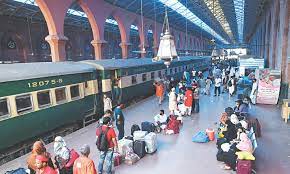The Supreme Court of Pakistan Thursday allowed Pakistan Railways to lease its land after getting approval of its rules from the Parliament or the federal cabinet. According to the details, a three-member bench of the apex court headed by Chief Justice of Pakistan, Justice Umar Ata Bandial was hearing the review petition of the federal government against the Supreme Court’s ban on the leasing of Railway property dated back in January 2019. During the course of the hearing, the honorable Chief Justice remarked that it was not the job of the state institutions to do business, however, our state institutions are in losses because they are overburdened.
Pakistan Railway, once a booming sector of Pakistan’s economy during the early days of the Country’s Independence, now relies on government grants to run its routine operations. The main reasons behind Railway’s decline were underinvestment, overstaffing, political interference, institutional corruption, and idle peddling on unprofitable routes as well as the closure of cargo service across major cities over the past two decades. Once the primary mode of intercity and the interprovincial journey has now become the second priority for the masses due to prolonged delays in train schedules, insufficient facilities along with overcrowdedness. According to the statistics, Pakistan Railways had a 73 percent share in freight traffic during the 1950s and 1960s which had been reduced to below 4 percent in recent years. Currently, the majority of the cargo business is being handled by the NLC and private sector, while thousands of cargo wagons are parked unused at various railway stations for years.
Historically, Pakistan Railway is the second largest institution after the Pakistan military which has a countrywide infrastructure, including railway stations, rail tracks, and hundreds of thousands of acres of commercial and residential land and properties worth billions of rupees. Pakistan Railway annually generates millions of rupees from its rented properties, railway vendors, contractors as well as private firms which share railway operations on various tracks, particularly branch lines. Factually, Railways authorities have now paused their endeavors to revive railway businesses in passengers transportation and cargo handling and spared these avenues for private giants thus Railways’ top brass is more interested in making money out of auctions of Railway assets, trading of institutional ruins and renting of Railway stations, railway tracks, engines, and buggies for advertisement and publicity purposes by private entities.
There had been casual efforts to make this huge transport system a profitable business through multiple recipes including Railway vision 2025, but recurrent changes in policies, institutional leadership as well as political governments led the department to non-implementation of plans, and thus a gradual decoy is continuing in already exhausted setup.
In fact, no genuine effort had ever been made by the administrators to overcome institutional losses and transform the railway into a lucrative setup. Ostensibly, all miracles could be visualized in the modern world if Railway high-ups spare a few hours for their primary job, otherwise, time is not far when Railway facilities would be used as museums and recreational places for the public.







